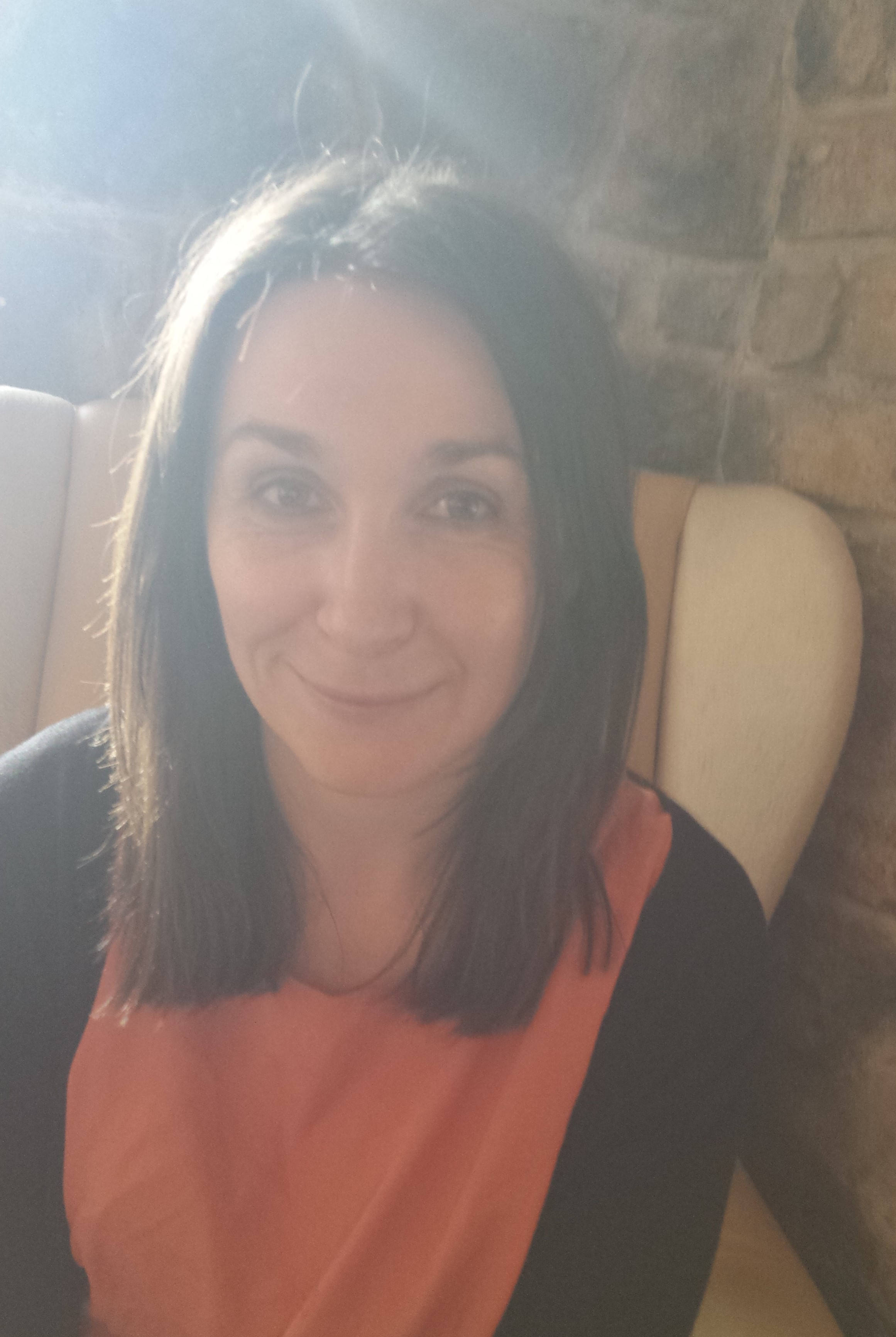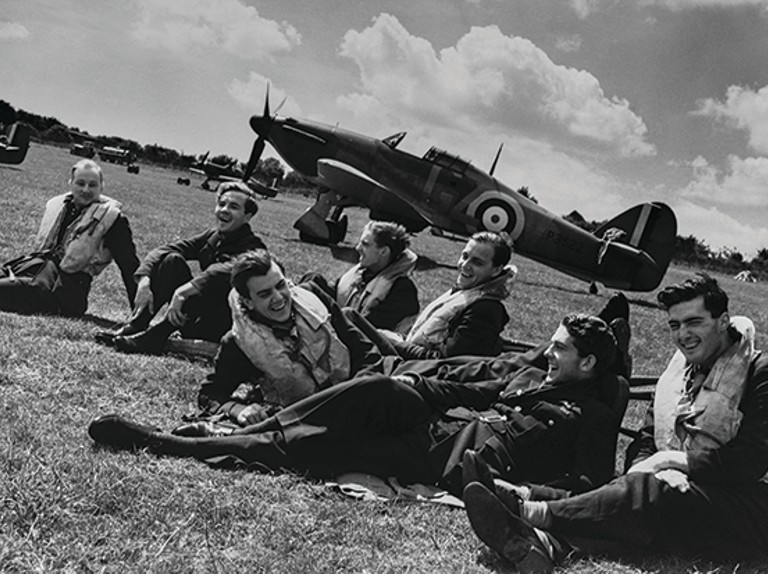The flying aces of the RAF played a vital role in the Battle of Britain 80 years ago, and their stories are told in Kitted Out, my new book on style and youth culture in the Second World War. Read an extract, below.
On what would have been her son Richard’s fortieth birthday in April 1959, Edwyna Hillary reminisced about the last summer holiday he and his University Air Squadron friends had spent together before the outbreak of war. ‘They all knew the war was coming,’ she said. ‘I’m glad he had that last summer.’ That summer, Richard Hillary and his fellow long-haired boys signed up to the Volunteer Reserves, and after completing RAF training at the base at Kinloss in May 1940, they relished the attention they would receive from their pilot’s wings now sewn onto their tunics. They all felt the thrill and promise of adventure, yet none would survive the end of the war. Richard, who found fame for his wartime memoir, The Last Enemy, was posted to Montrose, in north-east Scotland, as part of 603 Squadron with Peter Pease, Peter Howes and Colin Pinckney in 1940.
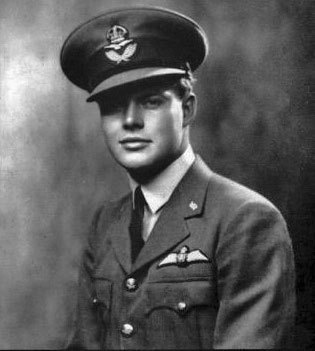
As Germany expanded its air force, the British Government needed to build up the RAF to ensure a firm footing in case of war. The RAF Volunteer Reserve (RAFVR), introduced in 1936, opened up flying to the lower-middle classes. These auxiliary squadrons had a reputation as ‘weekend flyers’, and the public in the 1930s was shocked by their rebelliousness. They drank heavily, drove fast sports cars and recklessly performed aerial stunts.

In the summer of 1939, Tony Bartley trained at No. 13 Flying School in East Lothian, Fife. He and his friends bought a sailboat they named Pimms No. 4. He went into Edinburgh every Saturday for ‘drink safaris’, flew right under the Forth Road Bridge and ‘fell madly in love with the Lord Provost’s daughter’. Bartley was born in Dacca, Bengal to an Irish district judge in the Indian Civil Service. At 14 he was sent to school in England, but he was uninterested in studying and planned to work for the East India Company. However, after a soul-destroying apprenticeship at a chartered accountants firm, he began taking flying lessons. As well as the sense that he must protect Britain from the Luftwaffe, his decision to join the air force was triggered by a visit to Germany, where he witnessed the maltreatment of Jewish citizens.
By 1945, over 1 million men and women were in one of the strands of the RAF. Fighter Command protected the skies above Britain by holding back the German Luftwaffe. Bomber Command led dangerous bombing raids to target strategic sites in occupied Europe, while Coastal Command kept the sea lanes open, preventing Britain from being starved into surrender. Friendships were formed within these strands, with shared experiences and rituals and their own distinctive styles. According to Cecil Beaton, who carried out a photographic study of the RAF, bomber pilots seemed ‘to possess a reserve born of their great responsibility to their crew’, while fighter pilots were ‘the gay, more reckless ones, more temperamental, perhaps a bit selfish’. Members of Fighter Command left the top button of their uniform tunic undone, which became known as ‘Fighter Boy style’.
As well as being nicknamed the ‘Glamour Boys’ for the way they wore their uniform with desirable panache, they were also called the ‘Brylcreem Boys’, because of their movie-star hairstyles. County Chemicals of Birmingham, who produced Brylcreem, jumped on the association and used an RAF man in tunic and cap to advertise their products.
Richard Hillary was particularly vain about his hair, becoming paranoid when some of his crewmates made a joke about dandruff. Gerald Stapleton, who served in 603 Squadron with Richard and was nicknamed ‘Stapme’, after a phrase from his favourite comic strip Just Jake, said: ‘Hillary was a very nice chap; he was a year older than I was. He was very well dressed, very good-looking with a typical university hairdo – long hair! Not long as we know it today, with a pony-tail, but much longer than our hair, although ours wasn’t too short. But Hillary’s was over his ears and over his collar, and we weren’t allowed to have that!’
The prestige of their uniform also meant they could be arrogant – they referred to the boys in the army as ‘the brown jobs’ for their poorly fitting khaki uniforms and for their lack of freedom in comparison.
Their blue uniforms, with the silver wings sewn onto the tunic, were incredibly alluring. Colin ‘Hoppy’ Hodgkinson, an acquaintance of Richard Hillary’s, lost both legs in an air accident in 1938, and after being posted into 131 Squadron in 1942 he felt rehabilitated by his new uniform. He wrote in his autobiography, ‘Air Force Blue, at that time the most famous colour in the world … I smoothed the wings above my left breast pocket, prinked like a mannequin up and down before a glass. My God! Nothing could stop me now. I was irresistible!’
Joan Wyndham and her friends, who had signed up as WAAFs, referred to the men who worked on the ground as ‘wingless wonders’ – they were invalidated because they didn’t wear the air force blue uniform. ‘I can’t describe the effect wings have on a WAAF,’ she wrote in her memoirs. ‘Our theme song should really be “If I Only Had Wings”.’
After earning his wings, Tony Bartley was posted to the infamous 92 Fighter Squadron. Based at Biggin Hill during the Battle of Britain, had a reputation for daredevil bravery and hedonism. Flyers like Bartley, Robert ‘Bob’ Tuck and Brian Kingcombe became household names as they fought off the Luftwaffe in air battles multiple times a day. They headed to London’s nightspots in fast cars powered by aviation fuel to drink away their stress. Bob Tuck was known as a wild aerobatic pilot and a fighter. As painter Cuthbert Orde said, ‘Everyone knows Bob Tuck: flat-out for fighting and flat-out for parties.’

Tony Bartley recalled first meeting Tuck ‘lounged out of his cockpit, a silk scarf draped around his neck, a monogrammed handkerchief drooping from one sleeve. He lit a cigarette in a long white holder, and strolled towards our CO.’
They were, as Tony Bartley wrote: ‘a generation born to war, as a generation earlier our fathers were. Some of us were men, but most still boys …we were fit and fearless, in the beginning. By the end, we were old and tired, and knew what fear was …We expected to die, but, in the meantime were determined to live every minute of each day. Aeroplanes were our first love, followed by girls and alcohol. All three were indispensable to our existence.’
The Glamour Boys often mixed in celebrity circles and dated London stage actresses. As ‘The Few’, the exclusivity of the RAF attracted celebrities like Richard Attenborough, Richard Burton, Denholm Elliott, Rex Harrison and Christopher Lee. Guy Gibson married actress Eve Moore, after meeting her backstage at a show; Richard Hillary and Hollywood star Merle Oberon had a love affair during his visit to America; and Tony Bartley married Deborah Kerr in 1945, after being introduced in Brussels when she was putting on an ENSA (Entertainments National Service Association) show of Gaslight with Stewart Granger. He remembered her ‘strawberry complexion, a shy warm smile and a little plumpness accentuated by the Khaki uniform she wore’.
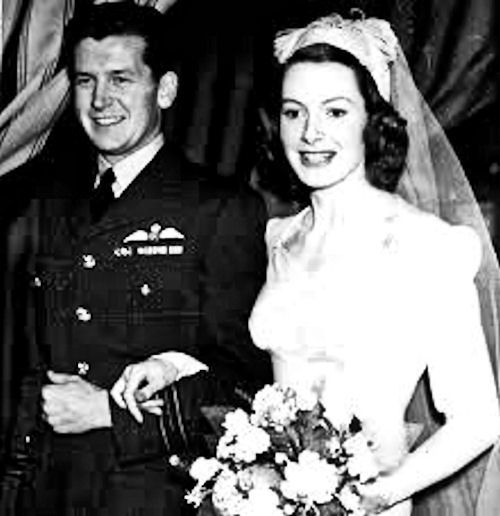
Legend recounts that it was stage actress, Lily Elsie, who chose the blue colour of the uniform for the newly launched service in 1918. The precursor to the RAF, the Royal Flying Corps, was established in May 1912, with a khaki service uniform of folding cloth cap, double-breasted tunic, cord breeches, brown ankle boots and a Sam Browne belt. Admiral Mark Kerr, consulting on the design of the new RAF uniform, was dating Elsie, who was starring on stage in The Merry Window. When he asked her views on a new colour to replace the existing khaki, she picked out the shade that ‘matches the colour of my eyes’.
A whole range of kit was provided by the RAF, and this could be adapted to follow the style of their particular squadron. A typical pilot’s equipment was a flying helmet, goggles, oxygen mask, leather Irvin jacket and ‘Mae West’ life jacket. A blue-grey greatcoat was worn over their service dress. NCOs (non-commissioned officers) were issued with a heavy serge coat, while officers could have theirs tailored, belted and made from a lighter fleece cloth. They were also issued with a Sidcot suit, a one-piece flying suit in lightweight waterproof green cotton, lined with fleece and based on a design from the First World War.
Group Captain Douglas Bader, who lost both legs before the war, liked to wear a 1930 pattern flying suit, as he could keep his artificial legs in one, ready to scramble. Some chose to buy their own white or black ‘Prestige’ one-piece flying suits, or to custom-make a version of the army battledress uniform in blue. However, the majority of pilots chose to fly in their service uniform of shirt, tunic and trousers, partly down to the hot weather during the summer of 1940 when the Battle of Britain raged.
Flying officer Harold Bird-Wilson of 17 Squadron said: ‘We flew in ordinary uniforms. We had no overalls in those days. We had jolly good sheepskin lined flying boots, leather gloves and helmets. We had sheepskin leather jackets and Mae Wests … we sometimes used to sleep at our dispersal points. Some pilots actually scrambled and flew in their pyjamas. While the Irvin jacket and matching Irvin suit trousers with braces were often seen in press photos, they were bulky and restricting, and not popular for flying. Originally manufactured by the Irvin parachute company, the jackets were made from thick-pile sheepskin, dyed brown, and with ‘Made in England’ on the zips to the front and cuffs.
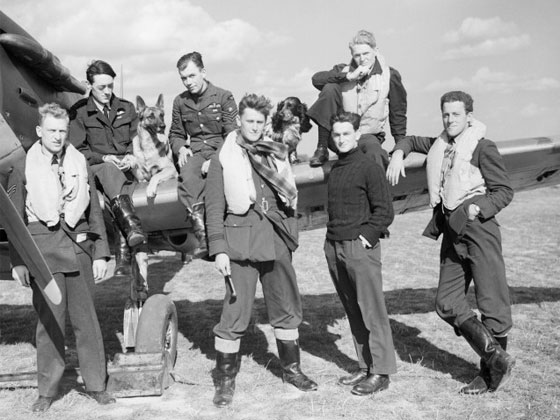
Some pilots also felt the black leather fleece-lined boots were too cumbersome, and instead preferred to wear their service shoes which were quicker to remove in an emergency. A hazard of wearing a shirt and tie under their Mae Wests during combat was that if the pilot landed in the sea, the shirt collar shrank in water and they could be throttled by their tie. The RAF issued new shirts with detachable collars, but some preferred to wear their cream woollen crewneck, which was much softer on the neck. Many pilots chose a debonair silk scarf around the open neck. They bought their own scarves, usually with a silk side for appearance and a wool side for warmth, and in school stripes, paisley pattern or polka dots. It was a prized possession for a girl to be given one of these.
‘Air combat was a personal, individual challenge, because we fought alone, man against man. A contest of gladiators in the vast arena of sky,’ wrote Tony Bartley. The RAF had a reputation for being scruffy and careless in how they dressed. Miles Tripp, a Lancaster bomber, remembered, ‘My hair hadn’t been cut for months and I never wore the standard forage cap; my dress was a mixture of flying gear and ordinary uniform topped by the red scarf’.
In his memoirs, Richard Hillary described how ‘Stapme’ Stapleton was ‘always losing buttons off his uniform and had a pair of patched trousers which the rest of the Squadron swore he slept in’. Another fashion was for a moustache, which was an attempt to pay homage to the established RAF pilots of a generation before.
Stapleton said: ‘It was a trend that I believe came from the fact that a number of older, although not necessarily more experienced, pilots came to us from Army Co-operation squadrons after the battle for France. We simply decided to grow moustaches in order to make us look older. We were conscious of how much younger we looked than them.’

Despite the individualism, there was also a certain degree of conformity and tribalism in the RAF. In the briefing rooms, bombers all tended to wear rollneck pullovers. 601 Squadron lined their tunics with bright red silk, as did Richard Hillary. In a pastel portrait, Eric Kennington depicted him with his battledress deliberately left open revealing a slash of luxurious red lining.
As the Battle of Britain raged in August 1940, Richard Hillary’s 603 Squadron was sent to Hornchurch. They arrived on 27August, and were immediately in the centre of the action. Group Captain C.A. ‘Daddy’ Bouchier remembered the arrival of this unlikely auxiliary squadron, hands in pockets, hats perched on the back of their head, and who he described as ‘the motleyest collection of unmilitary young men I had seen for a very long time’.
The day after they arrived, 603 Squadron were thrown right into the intense battles, and on this first day they lost three of their men. Drinking was their outlet when off duty. According to Tony Bartley, to cope with the unrelenting wave of Luftwaffe and the loss of their friends, they needed ‘the alcoholic tranquilizer and stimulant in order to keep going, all the time’.
He described the cycle of fighting during the Battle of Britain: ‘The boys converged from various rooms of our barrack block, dressed in polo-necked sweaters, corduroy trousers and flamboyant scarves. In the dispersal hut, heated by the pot-bellied stove, they waited for the warning that the enemy were coming. I watched the boys lying on their iron cots in Mae Wests and flying jackets, some tossing in uneasy sleep. Others played nervously with flying helmets and oxygen tubes or studied enemy aircraft identification charts.’
One survival technique was to treat death as a joke. Irish nurse Mary Morris, whose diaries recorded her time in the Queen Alexandra’s Royal Army Nursing Corps (QAs) in London and overseas, knew Irish flying hero, Brendan ‘Spitfire Paddy’ Finucane, as both their families had fought the British in the 1916 uprisings.
She noted that he played ‘the game of nonchalance as usual, as he drank beer from his own special pot’, and the RAF were ‘a special kind of people, outwardly talking in clichés and using their own “in” language. They are a law unto themselves, top tunic button undone, droopy moustaches.’
She added: ‘The RAF are the heroes of today, but too much is expected of them. The pilots have their mugs hanging above the bar, and if somebody fails to return from a mission, the mug remains there, but his name is never mentioned, not even by his closest friends. They are a strangely superstitious bunch of boys, many just down from Oxford. The ‘few’ are now becoming fewer so we must hope that Jerry eases up for a while. They are all so brave and so desperately tired.’
92 Squadron was nicknamed the ‘92nd Night Club’ because they held dances in their mess, entertained celebrities including Laurence Olivier, Vivien Leigh and Noel Coward, and even had their own jazz band. Their partying caused alarm to senior RAF officers and a psychologist was sent to assess them. He declared that, despite their antics, they were still able to do their job. However, in order to implement greater discipline, a curfew in the mess and uniform rules were enforced. They could no longer wear check shirts, suede shoes, red trousers or pyjamas under their flying kit.
Benzedrine was issued to airmen to keep them alert during missions, yet, because it was a stimulant, it was also used as a party drug. Tony Bartley recalled parties in the mess at RAF Hornchurch in May 1940, when Spitfire pilot Bob Holland knocked back his Benzedrine with whisky and hammered out frantic music on the piano.
Like other fighter pilots, Richard Hillary felt claustrophobic wearing his goggles, so he slipped them up onto his forehead. Richard also chose not to wear his leather gloves and RAF silk liners underneath, and for this, like many other pilots, he would pay a stiff price.
When his plane was hit on 3 September 1940, he managed to escape the burning plane despite terrible injuries to his face and hands, and was rescued from the English Channel. His severe burns allowed him entry into the so-called ‘Guinea Pig Club’, a group of RAF men who had suffered disfiguring burns and were treated by pioneering plastic surgeon Archie McIndoe at the Queen Victoria Hospital in East Grinstead.
In the summer of 1940, McIndoe found he was dealing with a new kind of injury known as ‘airmen’s burn’, where the severity of an aviation fuel fire caused severe burns to the areas not covered by protective clothing. A total of 4,500 airmen were burnt during the war, and those who suffered the worst burns had chosen not to wear their protective clothing, particularly during the hot summer of the Battle of Britain.
Pilot Officer Geoffrey Page, shot down on 12 August, recalled that he and Richard both suffered the same injuries to their hands as they had not been wearing gloves. ‘In 1940 an unofficial order had gone out that you must wear gloves and you must wear your uniform jacket under your flying jacket,’ he said. ‘The burns cases were so much worse, some were burnt to death, because all that they wore was a cotton shirt. When the aircraft caught fire you only had a few seconds in which to get out. If you didn’t get out in that time you never would. There was an appalling number of hand burns. When I finally returned to flying I was always careful and put gloves on, in fact I had a pair specially made with zippers running down one side to enable me to put them on easily.’
Richard, who had grown up with the reassurance of his own good looks, was now faced with painful and life-changing injuries as his eyelids, cheeks and lips had been destroyed. In his memoir, he recalled that his mother, sitting by his bedside, told him that he should be glad this happened to him, as ‘too many people told you how attractive you were and you believed them. You were well on the way to becoming something of a cad. Now you’ll find out who your real friends are.’
During his time recovering in hospital, Richard received the news, one by one, that his friends were killed – first Peter Pease and Peter Howes, then Noel Agazarian, and Colin Pinckney in January 1942. ‘That left only me – the last of the long-haired boys. I was horrified to find that I felt no emotion at all.’ Richard was a memorable figure in the East Grinstead ward, wearing bright red pyjamas for good luck, a long dressing gown and a varsity scarf, and with a gold cigarette holder in his mouth, described by Page as ‘the fried Noel Coward look’. The ward sister disapproved of his flamboyant pyjamas. ‘It’s the wrong address you’re at with those passion pants,’ she told him. ‘This is the hospital, not an English country house weekend.’
Despite the pride he felt in his blue uniform, embellished with wings, and the burns injuries which branded him a hero, Richard was haunted by the deaths of his friends and, feeling like a failure, he knew he wanted to go up in the air again to experience the comradery of the mess once more. Richard should not have been permitted to return to flying, since his hands were so severely burned, but on 15 November 1942 he was posted to RAF Charterhall for operational training.
His book, The Last Enemy, had been published to great plaudits and success, and Richard was a celebrity amongst the new group of young men who looked on him with awe. But his hands were not strong enough to control the twin-engine planes he was flying. In a letter to his girlfriend Mary, he described being helped into flying suit and boots by his radio operator and waddling to the plane looking ‘like an advertisement for Michelin Tyres’.
A few weeks before he died, Richard ran into an old friend, Colin Hodgkinson, who recorded their last conversation. ‘Goodbye Colin, I don’t think I’ll see you again.’ ‘Why?’ I asked. ‘We might run into each other.’ ‘No,’ he said, smiling with his twisted lips. ‘I don’t think I’m to last it out.’ Richard was killed a couple of weeks later, on the night of 7 January 1943, along with his radio operator, when their plane crashed onto Crunklaw Farm in the Scottish Borders.
Reporting his death, The Scotsman newspaper wrote, ‘Hillary called himself, in mock disparagement, the “last of the long-haired boys”. He used the term to describe a band of Oxford undergraduates who all joined the RAF together and of who he was the sole survivor.’
Kitted Out: Style and Youth Culture in the Second World War in available to buy now.

